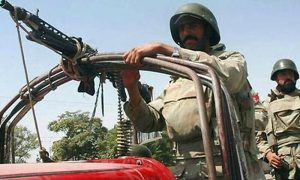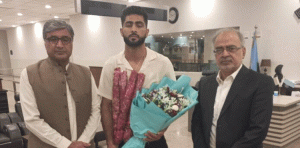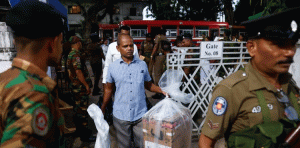

Opposition from political parties, peace campaigns, and civil society groups has cast doubt on its efficacy, leaving the public and observers questioning the fate of the operation.
In Khyber Pakhtunkhwa (KP), particularly in its former tribal districts, the word “operation” has become synonymous with fear and disruption. For many residents, it evokes memories of displacement and turmoil rather than security and peace.
“We’re tired of hearing about operations. They bring no peace, only displacement. They scare us now,” said Jaffer Mehsud, a trader from South Waziristan whose family was displaced in 2009 during Operation Rah-e-Nijat, a military offensive against the militant Tehreek-i-Taliban Pakistan (TTP) in the former tribal district.
“The new one, ‘Azm-i-Istehkam,’ is just another name for the same nightmare.”
Last month, the federal government, in a meeting comprising top civilian and military leaders, announced it was launching a comprehensive, nationwide anti-militant operation codenamed ‘Azm-i-Istehkam’ to mitigate a rise in attacks on security forces by militant groups. Ever since the announcement, however, the operation has been plagued by controversy.
Opposition from political parties, peace campaigns, and civil society groups has cast doubt on its efficacy, leaving the public and observers questioning the fate of the operation. Meanwhile, the government has sought to clarify that Azm-i-Istehkam would not be a kinetic large-scale military operation, nor would it entail the mass displacement of the local population.
For its part, Pakistan’s military has declared Operation Azm-i-Istehkam as an essential counter-terrorism campaign for national survival. Addressing a press conference in Rawalpindi last week, the military’s spokesperson Lieutenant General Ahmed Sharif Chaudhry said that a “massive, illegal political mafia” was trying to sabotage the drive through “organised propaganda”, while negating any notion of mass-scale displacement to be caused by it.
Analysts and officials monitoring the security situation warn that the government and military face significant challenges with this new operation compared to Operation Zarb-i-Azb, which was launched a decade ago.
While previous operations have struggled to eradicate terrorism from Pakistan, questions loom over the new operation’s potential effectiveness and the broader implications for national security. How will Azm-i-Istehkam navigate the complexities of a resurgent TTP and the shifting geopolitical dynamics following the Taliban’s rise in Afghanistan? Can it succeed without the unified political consensus and public support that were instrumental in past operations like Zarb-i-Azb?
Why a new operation?
The announcement of Operation Azm-i-Istehkam is a direct response to the rising tide of militant attacks in Pakistan, primarily by groups like the TTP and the Hafiz Gul Bahadur group. A brazen assault by the Hafiz Gul Bahadur group on a military base in Bannu last week, killing eight security personnel, underscored the escalating threat.
Baloch separatist groups, primarily the Baloch Liberation Army (BLA) and the Baloch Liberation Front (BLF) operate from their hideouts in Iran and also pose a persistent challenge, particularly in Balochistan province, with a focus on targeting Chinese interests.
Additionally, the Islamic State of Khorasan Province (ISKP) has also stepped up attacks within Pakistan in recent months.
Data from the Pakistan Institute for Peace Studies reveals a grim picture: a 17 per cent increase in terrorist attacks in 2023 compared to the previous year. This included a total of 306 attacks, with 23 being suicide bombings. The trend has persisted into 2024, with a suicide attack on Chinese engineers in Shangla in March, killing five Chinese nationals.
A section of analysts also suggest that growing Chinese concerns about security may have influenced the Pakistani government’s decision.
The resurgence of militant activities has been linked to the Afghan Taliban’s takeover of Afghanistan in August 2021, which has strained relations between Pakistan and the Taliban administration in Kabul.
This geopolitical shift has provided militant groups with a renewed sense of strength and resources, exacerbating the security situation in the region, according to analysts. The Taliban’s rise in Afghanistan seems to have emboldened the TTP within Pakistan. In March, for instance, Pakistan conducted intelligence-based operations inside Afghanistan to target militant groups, reportedly including airstrikes.
Earlier in September, an attack on military border posts in Chitral had prompted a crackdown on undocumented Afghan refugees in Pakistan, forcing over half a million Afghans to return to their country. Despite these measures, however, the attacks have continued unabated.
A history of military operations
Pakistan has a long history of counter-terrorism operations, with numerous campaigns launched since 2007. “Most of these military campaigns focused on the former tribal districts,” explained Lehaz Ali, a Peshawar-based journalist who studies militant groups in the region.
In 2007, the first major operation, ‘Rah-e-Haq’, was launched against local Taliban militants in Swat. The situation deteriorated again in Swat in 2009, leading to another military operation — ‘Rah-e-Rast’. That same year, Operation ‘Rah-e-Nijat’ was launched in the Mehsud areas of South Waziristan. Smaller operations, such as Sher Dil (2008), Daraghalam (2008), Biya Daraghalam (2009), Khwakh Ba De Shum (2009), and Operation Zalzala (2008) were conducted across the former tribal areas.
The largest operation to date, Zarb-i-Azb, commenced in 2014, followed by Radd-ul-Fasaad in 2017, which expanded the counterterrorism focus nationwide.
“The Zarb-i-Azb operation significantly reduced terrorist activities and brought relative stability from 2014 to 2019,” said Ali. He noted, however, that the security situation began deteriorating in 2020, and worsened even further after the Taliban captured Kabul in August 2021.
This time, however, the Pakistani military says Operation Azm-i-Istehkam is markedly different. “Comparing Azm-i-Istehkam to past operations like Zarb-i-Azb and Rah-i-Nijat is not appropriate,” said DG ISPR Chaudhry in last week’s press conference.
He stressed that Azm-i-Istehkam is not merely a military manoeuvre but a “comprehensive counter-terrorism campaign” designed to restore stability across the country. “A narrative is being built that the operation would displace people, similar to Operation Zarb-i-Azb,” said Lt Gen Sharif. “But the purpose of the operation is to reinvigorate the already in-place National Action Plan (NAP).” He did not, however, divulge specific details or even a launch date for the operation.
It is worth noting that Pakistan announced a similar military operation in April 2023, but it never materialised. So how will the new operation be different, particularly in light of the current challenges faced by the country?
Challenges facing Operation Azm-i-Istehkam
While the military has previously demonstrated its capacity in Operation Zarb-i-Azb to inflict significant blows to these militant outfits, the current landscape is markedly different, presenting a host of obstacles.
Muhammad Feyyaz, a Lahore-based academic specialising in terrorism studies, noted that while Pakistan’s series of counter-terrorism operations have achieved successes, “those successes have not been sustained due to the lack of support from the civilian government”.
“The military can only address a portion of the problem. The root causes of political violence and terrorism lie outside its purview and require a comprehensive, civilian-led strategy,” he explained. Feyyaz stressed the importance of the civilian government as the primary stakeholder, insisting that the need for and direction of any operation must be driven by the civilian leadership.
Recognising the complex and non-linear nature of the conflict, Feyyaz advocated for a more holistic approach involving social scientists and policy analysts. He also stressed the importance of demobilisation, reintegration, and rehabilitation programmes for achieving sustainable peace and stability.
Lack of political consensus and public support
Unlike the unified national resolve that fuelled Operation Zarb-i-Azb, the current operation faces significant challenges due to a fragmented political landscape and limited public support.
The attack on Karachi airport and the subsequent Peshawar school massacre in 2014 galvanised the nation behind Zarb-i-Azb, securing backing from major political parties, civil society, and the media. In contrast, today’s political climate is deeply divided.
Khyber Pakhtunkhwa province, the epicentre of TTP violence, is particularly crucial. A lack of public support there could significantly hinder the operation’s effectiveness.
Major political parties, including the ruling Pakistan Tehreek-e-Insaf (PTI) in KP, Jamiat Ulema-i-Islam-Fazl, and the Awami National Party, have publicly opposed the new operation, citing fears of large-scale displacement.
Ali Amin Gandapur, KP’s chief minister, met with incarcerated party chief Imran Khan in Adiala jail, Rawalpindi, last week. Following the meeting, Gandapur told the media that the PTI chief had instructed the party to oppose the new military operation and that the provincial government should not participate in any decisions related to the operation.
Furthermore, the Pashtun Tahaffuz Movement, a campaign popular in the former tribal areas, and several district-level peace jirgas have also voiced their opposition, organising rallies to protest the newly announced operation.
Analysts suggested that the PTI and PTM’s opposition to the operation stems from their own tensions with the military.
“If the PTI was in the central government, they would have also supported the operation, but because of the political tensions with the military, its provincial government is strongly opposing it,” said Ali.
A resurgent and adoptive TTP
In 2014, when Operation Zarb-i-Azb was launched, the TTP was already weakened by internal conflicts, with some of its leaders defecting to the newly arrived militant Islamic State (IS) in the region and others eliminated through US drone strikes.
Today, however, the TTP has regrouped, uniting its fragmented factions and incorporating dozens of new groups, including smaller cells linked to al-Qaeda and sectarian outfits. Recently, the TTP announced that a new group from Dera Ismail Khan, led by Khalid Kochi, has joined its ranks.
“The TTP has become more shrewd than a decade ago, avoids civilian casualties, and finds refuge in Afghanistan,” said Adam Weinstein, Deputy Director of the Middle East Program at the Quincy Institute.
By primarily targeting Pakistan’s security forces instead of civilians, the TTP has developed a strategy that allows them to escalate their war against the state without provoking a massive response from the military or the general public, he said.
Afghanistan: A safe haven
While previous operations targeted TTP networks operating from within Pakistan, primarily from its headquarters in North Waziristan and adjacent districts, the group has now established itself in Afghanistan.
“The situation is far more complex today,” said a Peshawar-based senior law enforcement official. “They’ve dispersed throughout the country with hideouts in neighbouring Afghanistan.”
The official noted that the Taliban regime is not only providing sanctuaries to the TTP but also arming them with modern weapons and sophisticated night vision devices left behind by US-led coalition forces withdrawing from Afghanistan.
“Without eliminating the TTP’s hideouts in Afghanistan, terrorism in Pakistan will persist in one form or another,” he warned.
Despite tense relations with Islamabad, the Ashraf Ghani-led administration in Kabul had previously arrested hundreds of TTP militants, including the group’s deputy chief Maulvi Faqir Muhammad and former spokesperson Muhammad Ali Balti. However, after the Taliban captured Afghanistan, they released all TTP militants from Afghan jails, further complicating the security landscape.
Economic constraints
Counterterrorism operations require substantial resources, including investments in intelligence gathering, technology, and personnel. “In 2014, Pakistan was comparatively better equipped,” noted journalist Ali. “We had economic stability, political support, and US funding.”
However, Pakistan’s current economic challenges, marked by mounting debt and financial instability, could hinder the effectiveness of Operation Azm-i-Istehkam.
“It’s doubtful whether Pakistan could sustain a full-fledged campaign against the TTP. It’s a matter of bandwidth and resources,” said Weinstein.
Diminished US support
The new operation has been announced in an environment where the US has withdrawn from Afghanistan, leaving no international funding available for counterterrorism campaigns.
During Operation Zarb-i-Azb, US intelligence sharing and drone strikes were instrumental, with most TTP leaders killed by US drone attacks. The absence of such support in the current operation is a significant setback, as Pakistan now faces the challenge of conducting counterterrorism efforts without the same level of external assistance.
Last month, Pakistan’s envoy to the US, Masood Khan, urged Washington to provide small arms and modern equipment to ensure the success of Operation Azm-i-Istehkam. He made these remarks while addressing US policymakers, scholars, intellectuals, and corporate leaders at the Wilson Center, a Washington think tank.
It remains to be seen whether the solicited help will make its way to Pakistan. For now, however, the military and the civilian leadership must find a way to overcome these challenges and enlist the support of all stakeholders to ensure the operation’s success. Failure to do so could embolden the militant groups and cause the security situation to deteriorate even further.






